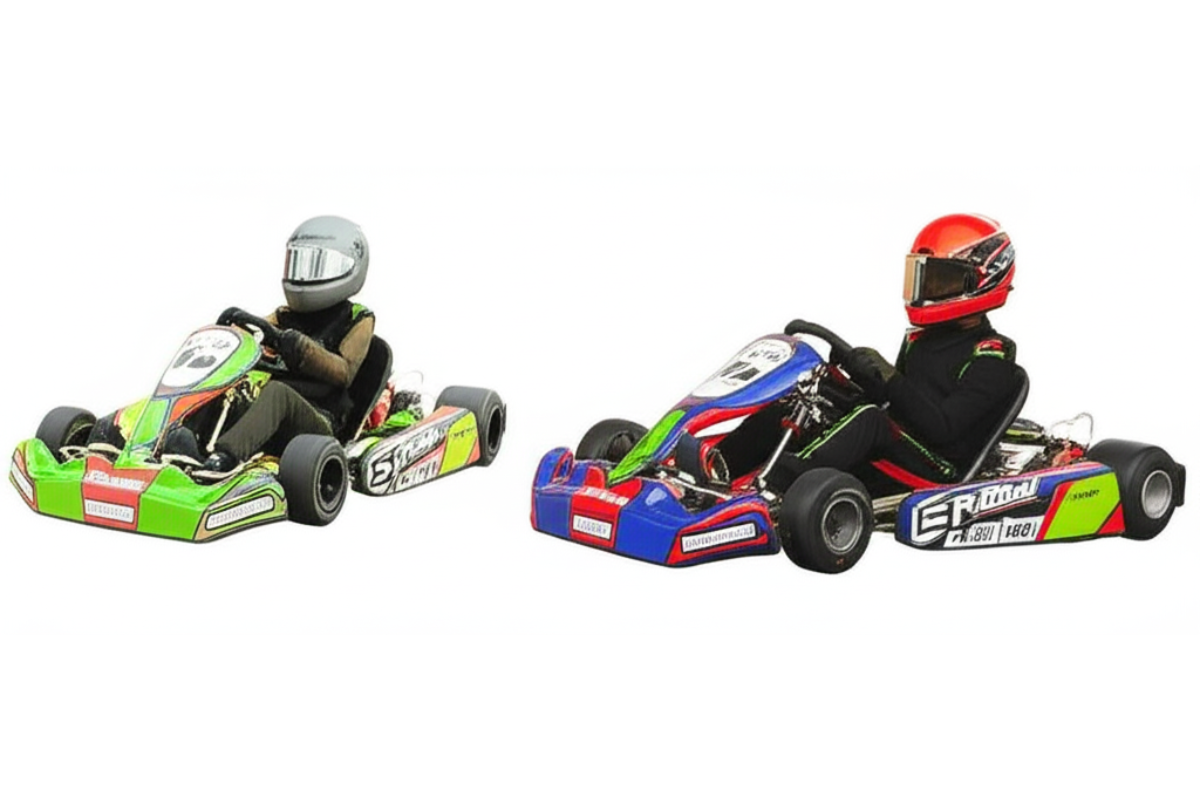Go-karting is an electrifying activity, a fantastic way to experience the thrill of speed and competition. Whether you’re tearing around a local rental track with friends or competing in a serious racing league, the need for proper protective equipment is absolute and non-negotiable. Think of it as your personal safety net, the barrier between you and potential injury in a sport that, while generally safe, does carry inherent risks. Understanding what gear to wear and, crucially, why each piece is essential is the first step towards a safe and enjoyable karting experience. This comprehensive guide will break down each vital piece of protective equipment, explaining its function and the critical role it plays in safeguarding you on the track.
Shielding Your Most Important Asset: The Helmet
The helmet is the cornerstone of karting safety. It’s the primary defense for your head, the most vulnerable part of your body in the event of an accident.
What It Does: Impact Absorption and Protection
A high-quality karting helmet is designed to absorb and dissipate the energy from an impact, preventing or minimizing head injuries like concussions, skull fractures, and lacerations. It also provides a crucial barrier against abrasions from the track surface and protects your face and eyes from flying debris, wind, and the elements. The visor ensures clear vision, which is paramount for safe driving.
Key Features to Look For: Certifications and Fit
When selecting a karting helmet, safety certifications are the most important factor. Look for helmets that meet or exceed standards set by recognized organizations such as Snell (SA2020 or newer for motorsports), FIA 8859-2015, or ECE 22.05. These certifications indicate that the helmet has undergone rigorous testing to ensure its protective capabilities.
Beyond certification, proper fit is absolutely crucial. A helmet that is too loose will not offer adequate protection as it can move during an impact. A helmet that is too tight will be uncomfortable and distracting. The helmet should fit snugly around your entire head, with even pressure and no significant movement when you shake your head. Your cheeks should feel slightly compressed. Always try on a helmet before purchasing and consult the manufacturer’s sizing chart.
Full-face helmets are highly recommended for karting as they offer the most comprehensive protection, including the chin and face. Ensure the visor is clear, provides a wide field of vision, and is free from scratches.
Guarding Your Torso: Racing Suits and Rib Protectors
While your head is paramount, your body also needs significant protection from impacts and abrasions. This is where karting racing suits and rib protectors come into play.
The Karting Racing Suit: More Than Just Appearance
A karting racing suit is specifically designed with durable, abrasion-resistant materials like Cordura or even fire-resistant Aramid fibers.
Abrasion Resistance and Impact Protection
In the event of a fall or slide, the suit acts as a protective layer, preventing or minimizing skin abrasions (road rash) caused by contact with the track surface. Many suits also feature strategically placed padding in areas like the shoulders, elbows, and knees to offer additional impact protection.
Fire Resistance: A Crucial Safety Feature
For more advanced karting or racing environments, fire-resistant suits are essential. These suits are designed to withstand high temperatures for a specific period, giving the driver precious seconds to escape in the event of a fire. Look for suits with FIA homologation for racing, which often includes fire resistance standards.
Fit and Comfort: Balancing Protection and Performance
A well-fitting suit is crucial for both safety and comfort. It should be snug enough not to flap around at high speeds but loose enough to allow for a full range of motion while driving. Breathable materials and ventilation features can enhance comfort during longer sessions.
The Indispensable Rib Protector: Shielding Your Vital Organs
The forces experienced during karting, particularly during high-speed cornering and over bumps, can put significant pressure on your ribs and internal organs. A rib protector is specifically designed to mitigate these forces.
Impact Distribution and Support
A rib protector typically features a rigid outer shell made of materials like fiberglass or high-density plastic, combined with energy-absorbing foam padding on the inside. It’s designed to distribute the impact forces across a wider area, reducing the pressure on individual ribs and protecting your vital organs.
Why It’s Often Underestimated but Crucial
Many novice karters might overlook the rib protector, but it’s a vital piece of safety equipment. Without it, you risk painful rib bruising, fractures, and even internal injuries. A properly fitted rib protector can significantly enhance your comfort and safety on the track.
Protecting Your Extremities: Gloves and Karting Shoes
Your hands and feet are the primary connection points for controlling the kart. Protecting them is crucial for both safety and performance.
Karting Gloves: Grip, Protection, and Comfort
Karting gloves are more than just hand coverings; they are designed to enhance grip, protect against abrasions and impacts, and improve overall control.
Enhanced Grip and Blister Prevention
The palms of karting gloves are often made from high-grip materials like synthetic leather or silicone, providing excellent control over the steering wheel, even when your hands are sweaty. They also prevent blisters and calluses that can result from prolonged gripping.
Impact and Abrasion Protection
Many karting gloves feature padding on the knuckles and back of the hand for impact protection. They also offer a layer of abrasion resistance in case your hands come into contact with the track or other parts of the kart during an incident.
Fit and Dexterity: Maintaining Precise Control
Gloves should fit snugly but allow for good dexterity and feel. Pre-curved fingers and external seams can enhance comfort and reduce fatigue.
Karting Shoes: Pedal Feel, Ankle Support, and Fire Resistance
Regular athletic shoes are not suitable for karting. Karting-specific shoes are designed with features that optimize safety and performance.
Thin Soles for Optimal Pedal Feel
Karting shoes typically have thin, sensitive soles made of durable rubber. This allows the driver to have maximum feel and control over the pedals, which is essential for precise throttle and brake modulation.
Ankle Support and Protection
Many karting shoes have a higher cut around the ankle, providing crucial support and protection against sprains and abrasions.
Fire Resistance: An Added Layer of Safety
Similar to racing suits, some karting shoes are made from fire-resistant materials, offering an extra layer of safety in the event of a fire. Look for FIA homologation if fire resistance is a priority.
Lightweight and Streamlined Design
Karting shoes are generally lightweight and have a streamlined design to prevent snagging on the pedals or other parts of the kart.
Often Overlooked but Increasingly Important: Neck Braces/Collars
While helmets primarily protect the head, the neck is also vulnerable to injury during the sudden accelerations, decelerations, and impacts common in karting. Neck braces and neck collars are designed to provide crucial support and limit potentially damaging neck movements.
Neck Braces (Head and Neck Support Devices): Maximum Protection
A neck brace, often referred to as a Head and Neck Support (HNS) device, is a more advanced piece of safety equipment designed to limit the range of motion of the head and neck during a crash.
Limiting Head and Neck Movement During Impact
These devices work by creating a connection between the helmet and the torso, preventing excessive forward, backward, or lateral movement of the head relative to the body during an impact. This significantly reduces the strain on the neck and spine, mitigating the risk of whiplash, compression fractures, and other severe neck injuries.
Increasingly Mandated in Competitive Karting
Neck braces are becoming increasingly mandatory in competitive karting due to their proven effectiveness in reducing serious neck injuries. Different designs exist, some attaching directly to the helmet and others integrating with the driver’s suit or a chest plate.
Neck Collars: Basic Support and Cushioning
A neck collar is a simpler piece of protective gear that fits around the neck.
Providing Basic Support and Reducing Whiplash Risk
While not as comprehensive as a neck brace, a neck collar provides a basic level of support and cushioning, helping to reduce the risk of whiplash and minor neck strains during less severe impacts. It also helps to keep the helmet more stable during aggressive driving.
A Good Starting Point for Recreational Karting
Neck collars are a good starting point for recreational karters seeking an additional layer of neck protection. However, for more serious karting or racing, a neck brace offers a significantly higher level of protection.
The Importance of Proper Fit and Maintenance
Regardless of the quality of your protective gear, it can only do its job effectively if it fits properly. Ill-fitting gear can be uncomfortable, distracting, and, most importantly, can fail to provide adequate protection in an accident.
Ensuring a Snug and Secure Fit
Take the time to try on all your gear before purchasing. Follow manufacturer sizing guides and ensure each piece fits snugly without being overly restrictive. Helmets should not move on your head, suits should allow a full range of motion, gloves should provide a good grip, and shoes should fit comfortably but securely. Rib protectors and neck braces should fit according to the manufacturer’s instructions.
Regular Inspection and Maintenance
Regularly inspect your protective gear for any signs of wear and tear, damage, or degradation. Check helmet shells for cracks, visors for scratches, suit seams for rips, and ensure all straps and closures are in good working order. Follow the manufacturer’s instructions for cleaning and storing your gear. Damaged or worn-out equipment should be replaced immediately.
Investing in Your Safety: Priceless Protection
While the initial cost of quality protective karting gear might seem significant, consider it an investment in your safety and well-being. The potential consequences of not wearing proper gear far outweigh the expense. Choosing certified, well-fitting equipment is the most responsible decision any karter can make.
By understanding what protective gear to wear and why each piece is crucial, you are taking a proactive step towards a safer and more enjoyable karting experience. So, gear up correctly, understand the importance of each item, and hit the track with the confidence that you’ve taken the necessary precautions to protect yourself. Your safety is paramount, allowing you to fully embrace the thrill and excitement that go-karting has to offer.
https://kartclass.com/blogs/news/what-protective-gear-is-required-for-kart-racing

Ramon Splinter is a passionate go-kart enthusiast and expert who shares valuable tips and insights on Zyorb, a blog dedicated to karting enthusiasts. With years of experience on the track, he specializes in helping beginners and seasoned drivers improve their skills, optimize their karts, and master racing strategies. His articles combine technical knowledge with practical advice, making go-karting more accessible and exciting for all.

